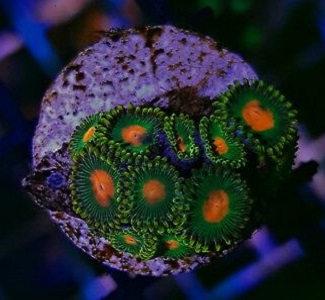Green Bay Packers Zoanthids are a remarkably popular zoanthid with a green skirt, leading into a blue-green face and ending in a mandarin orange mouth. The mouth can change color slightly depending on the lighting provided, ranging from gold to yellow to a deep orange. Like all of our polyps they are aquacultured specimens, many generations removed from the original wild starter colonies. Growth rate is moderate. They are easy to keep and are a excellent choice for the beginner reefer.
Zoanthids are actually not a species of coral. They are cnidarians, much like sea anemones. In fact, due to their nature, they are referred to as “colonial anemones”. Zoas tend to contain their zooxanthellae within their bodies. The zooxanthellae are what produce the fantastic colors that the zoas emit. In terms of body structure, the zoas have a similar body structure to sea anemones: an oral disc surrounded by tentacles, and a cylindrical body. If the title “colonial anemones” did not give it away, zoas usually form large groups and cover huge surfaces. Zoas also tend to emit a mucus-like substance with which to coat themselves.
Aggressiveness
They are a peaceful coral with the capability of being able to retract or deflate their polyps in response to a bothersome predator. They will not bother nearby corals since they do not have sweeper tentacles.
Water flow
We recommend a moderate level of water flow.
Lighting
Zoanthid care is relatively easy compared to coral and sea anemones. They require moderate to high lighting in order to take full advantage of the zooxanthellae’s photosynthesis.
Placement
Zoanthid Polyps may be placed anywhere which provides the required water flow and lighting level.
Diet and Feeding
What is also recommended is to feed the zoas directly. Zooplankton and cyclopleeze come highly recommended. Each zoanthid is different, so testing different kinds of food is highly recommended. The thing that makes these animals so easy to care for is their high tolerance for dirty water. While it is important to make sure that any tank is always clean, zoas will not be immediately harmed by dirty water. Something important to keep in mind when introducing zoas into a tank is that they multiply rapidly. In fact, zoanthids have been known to suffocate tank mates due to their sheer numbers.
Caution
One of the most fascinating aspects of the zoanthids is also one of the most deadly. There is a group of zoanthids known as Palythoas. These Palythoas secrete a poison through their mucus known as palytoxin. Palytoxin is extremely dangerous, and it affects humans in a very adverse way. What this toxin does is mess with the cells of the heart, destroying their ion regulatory systems. The toxin enters the system via open wounds, ingestion, and injection. If there is no open wound, the skin becomes very irritated. Because of the lack of treatment, what is highly recommended with these creatures is to wear protective gear, such as gloves and goggles, and to use tongs which will help distance the creature from any contact with the skin.
|



